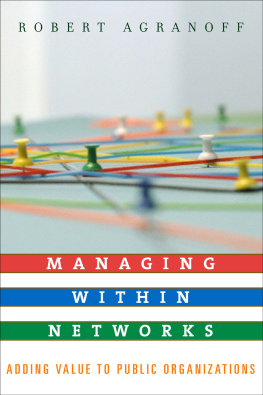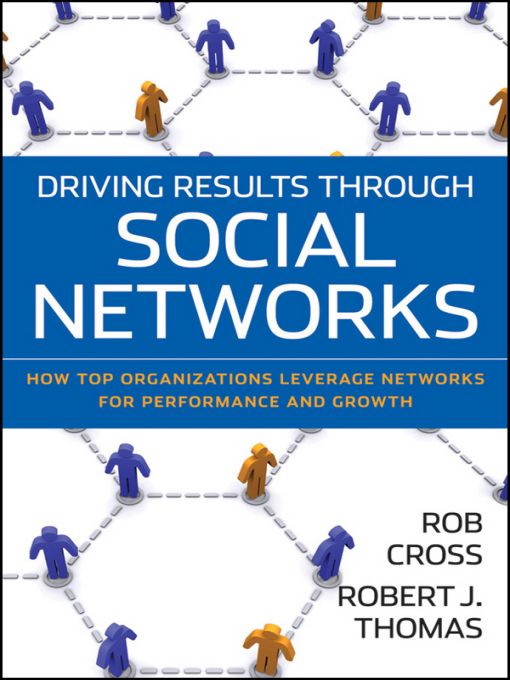Table of Contents
More praise forDriving Results Through Social Networks
This book delivers on its promise by showing how leaders can fuel performance and growth through better management of networks within and between organizations. Cross and Thomas use in-depth case examples to move beyond the hype of networks and demonstrate the strategic benefits that come from leveraging these traditionally hidden assets. Having used these ideas in my own organization, I strongly recommend this book as a guide for leaders aspiring to obtain a multiplier effect on the skills and expertise of employees throughout a company.
John Cammack, head of Third Party Distribution, T. Rowe Price Associates
Informal networks are how work really gets done. While they are likely your most precious resource, most executives dont know how to harness their power. Cross and Thomas describe how to use them to meet your strategic objectives.
Steve DAmico, director of Design Learning and Capability, The Procter & Gamble Company
People-centered managers have intuitively believed that improving connections at work result in significant quantifiable business impacts. Cross and Thomas now give us proof that this intuition is true! At MWH, weve used organizational network analysis inside our company and with our clients over the past five years to successfully manage organizational design, improve leadership and mentoring, facilitate change, and improve knowledge retentionwere believers. If you want to be a believer, let this book give you new insights and starting points for using this important, new approach to business management.
Vic Gulas, chief knowledge officer, Montgomery-Watson Harza
While individual know-how is critically important for our company, it is network-based knowledge and connections that drive our ability to act and operate globally, driving better business performance. Our best networks continuously analyze how they are actually functioning, enabling these networks to improve collaborative patterns and produce greater business value. This book breaks new ground in highlighting concrete connections between networks and business performance.
Dan Ranta, director of Knowledge Sharing, ConocoPhillips
Better networks mean better performance. Thats never been clear before this book, but now its obvious. If you know your business objectives, Cross and Thomas will help you understand how social networks can help you achieve them.
Thomas H. Davenport, Presidents Distinguished Professor of Management and Information Technology, Babson College
Organizational network analysis has become an indispensable way of thinking and framing knowledge sharing within the Defense Intelligence Agency and the Intelligence Community. We have used it to baseline the level of leadership collaboration, to implement a smart mentoring concept to pull up those at the periphery of frontline employees to be more influential with peers and leaders, and to show that greater diversity of ones network is directly correlated with higher performance. We have taken from Cross and Thomas more than they have givena performance improvement capability that is changing the landscape of organizations.
Adrian (Zeke) Wolfberg, director, Knowledge Laboratory, Defense Intelligence Agency
The Jossey-Bass
Business & Management Series
Preface
Most leaders readily acknowledge the importance and power of informal networks for getting work done in their organizations. Yet they generally spend little if any time assessing and managing these networksa mistake with substantial implications for innovation and performance. Network analysis provides a powerful means for leaders to understand and drive value through this seemingly invisible aspect of organizations. Does information flow smoothly across formal structures and allow the organization to leverage scale and expertise in product or service offerings? Is innovation spurred at key points by effective networks that knit together functions, offerings, and technical capabilities? Is the organization overly focused on a few decision makers, roles, or experts who are invisibly but dramatically slowing the work and efficiency of many others? Once networks become visible, leaders can address these and other questions in ways that have immediate impacts on performance.
Of course, network analysis is not new by any stretch. The approach has enjoyed a rich research tradition within anthropology, sociology, psychology, and management studies.
Yet although network analytics have advanced substantially over the past decades, the managerial applications of the ideas have not kept pace. This comparative lack of attention to business applications led Rob Cross to publish a book in 2004 on managerial uses of network analysis within organizations, as well as software to improve leadership effectiveness (a free preview of this application can be found at www.robcross.org). The ideas from this book, The Hidden Power of Social Networks, resonated with a wide range of organizations and led to the formation of a consortium called The Network Roundtable (http://www.thenetworkroundtable.org) to further explore business applications of network analysis. The Network Roundtable grew rapidly to include ninety influential and well-known companies and government agencies. Yet rather than develop another tool or diagnostic to apply to their organizations, members of the consortium asked that the research focus instead on specific ways that network analysis could help leaders identify improvement opportunities that cannot be unearthed with current frameworks (such as formal structure) or diagnostics (such as process maps, culture surveys, and employee engagement inventories). A daunting challenge issued by a tough, smart, and demanding set of leaders! But one that was unquestionably worth pursuing in close collaboration with these organizations.
The Network Roundtable was consequently organized to accomplish two important goals. The first goal was to teach members how to apply network analysis to critical business issues. Online tutorials, hands-on workshops, webinars, and accessible training materials were provided to enable members to undertake a range of projects in their own organizations. This resulted in a stream of innovations on the application of network analysis to key business issues as members with varied backgrounds and interests took up the ideas in their own waysan important process that often broke us free from existing paradigms of thought on network analysis.
The second goal of The Network Roundtable was to support a series of research programs that yielded actionable insights and measurable business impact. Over a five-year period these programs have focused on ways that network analysis can improve: (1) Innovation and Top-Line Revenue Growth, (2) Client Connectivity and Sales Force Effectiveness, (3) Large-Scale Change and Post-Merger Integration, (4) Talent Management and Leadership Development, (5) Strategy Execution and Alignment, (6) Financial Return Through Effective Collaboration, and (7) Lateral Connectivity in Organizations (such as Best-Practice Transfer). In each of these programs we worked with Roundtable members to understand the business results that leaders can attain through targeted improvement to networks.












